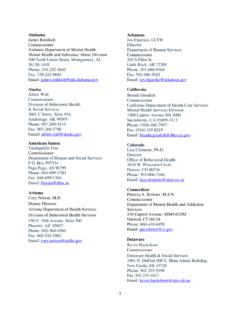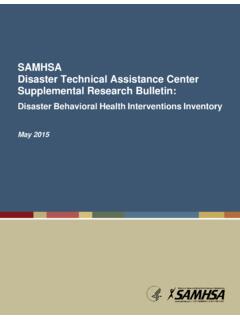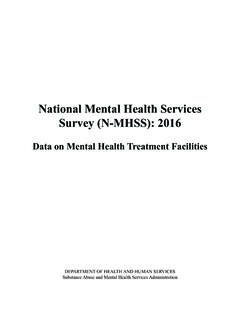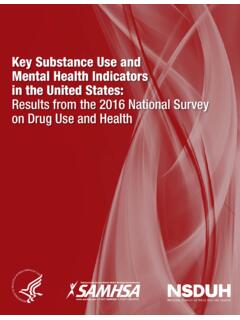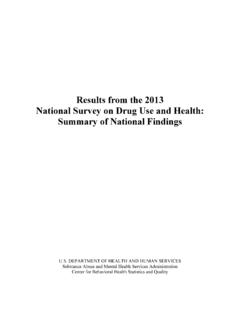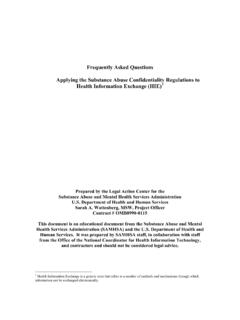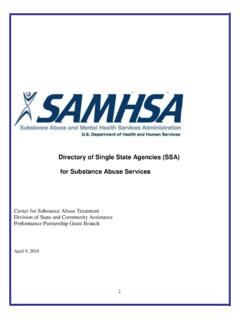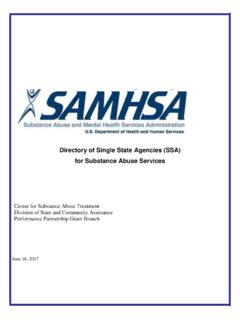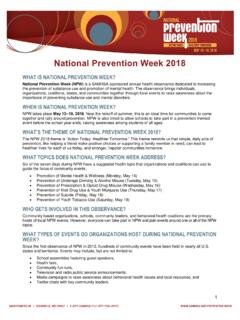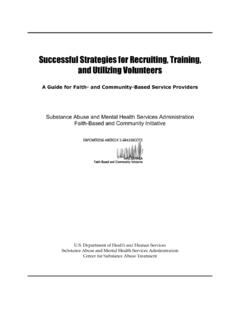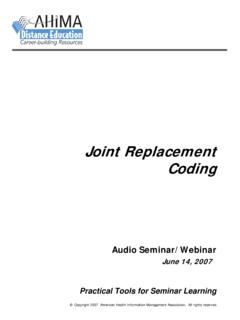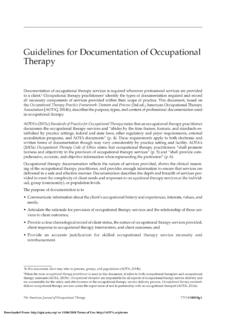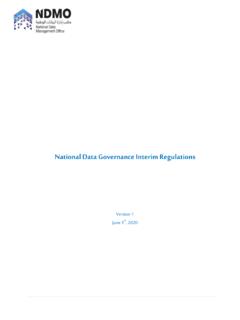Transcription of Understanding Patient Limit275 - SAMHSA
1 Understanding the Final Rule for a Patient Limit of 275 Which practitioners are eligible for a Patient limit of 275? Licensed physicians who have had a waiver to treat 100 patients for at least 1 year can become eligible for the Patient limit of 275 in one of two ways: 1) By holding additional credentialing (defined below); or 2) By practicing in a qualified practice setting (defined below). Additionally, practitioners must not have had their Medicare enrollment and billing privileges revoked and must not have been found to be in violation of the Controlled Substances Act (CSA). What additional credentialing is required for a practitioner using this pathway to become eligible for the Patient limit increase?
2 Practitioners who are using the additional credentialing pathway must hold board certification in addiction medicine or addiction psychiatry by the American Board of Addiction Medicine or the American Board of Medical Specialties, or certification by the American Board of Addiction Medicine or the American Society of Addiction Medicine.* What constitutes a qualified practice setting? Practitioners who are using the qualified practice setting pathway must practice in a setting that does the following: 1) Provides professional coverage for Patient medical emergencies during hours when the practice is closed. 2) Provides access to case management services for patients, including referral and follow-up services for programs that provide or financially support medical, behavioral, social, housing, employment, educational, or other related services.
3 3) Uses health information technology if it is already required in the practice setting. 4) Is registered for their state prescription drug monitoring program where operational and in accordance with federal and state law. 5) Accepts third- party payment for some services, though not necessarily for buprenorphine-related services and not necessarily all third- party payers. What is the process to request a Patient limit of 275? Eligible practitioners who want to increase their Patient limit to 275 must submit a completed Request for Patient Limit Increase form and a statement certifying that they do the following eight things: 1) Adhere to nationally recognized evidence-based guidelines for treating patients with opioid use disorder (defined below). *The language of the final rule also references certification by the American Osteopathic Academy of Addiction Medicine (often simply referred to as AOAAM) as part of the definition of additional credentialing.
4 The department is currently taking steps to clarify this reference. 1 2) Provide patients with necessary behavioral health services (defined below) either directly or through a formal agreement with another entity. 3) Provide appropriate releases of information in accordance with federal and state laws and regulations to permit coordination of care with behavioral health, medical, and other practitioners. 4) Use Patient data to inform improvement of outcomes. 5) Adhere to a diversion control plan to reduce the possibility of diversion of buprenorphine (described below). 6) Have considered how to ensure continuous access in the event of an emergency situation (defined below). 7) Notify all patients above the 100- Patient limit that they will no longer be able to provide Medication-Assisted Treatment (MAT) services using buprenorphine in the event that their request for the higher Patient limit is not renewed or the renewal request is denied, and will also make every effort to transfer patients to other treatment providers.
5 8) Practitioners must also provide any additional documentation to demonstrate compliance as requested by the Substance Abuse Mental Health Services Administration ( SAMHSA ). What are nationally recognized evidence-based guidelines? Nationally recognized evidence-based guidelines are documents produced by a national or international medical professional association, public health entity, or governmental body with the aim of ensuring the appropriate use of evidence to guide individual diagnostic and therapeutic clinical decisions. Some examples are the American Society of Addiction Medicine National Practice Guidelines for the Use of Medications in the Treatment of Addiction Involving Opioid Use; SAMHSA s Treatment Improvement Protocol 40: Clinical Guidelines for the Use of Buprenorphine in the Treatment of Opioid Addiction; the World Health Organization Guidelines for the Psychosocially Assisted Pharmacological Treatment of Opioid Dependence; the Department of Veterans Affairs /Department of Defense/ Clinical Practice Guideline on Management of Substance Use Disorder; and the Federation of State Medical Boards Model Policy on the Drug Addiction Treatment Act of 2000 and Treatment of Opioid Addiction in the Medical Office.
6 What are behavioral health services? Behavioral health services are any nonpharmacological interventions carried out in a therapeutic context at an individual, family, or group level. Interventions may include structured, professionally administered interventions ( , cognitive behavioral therapy or insight-oriented psychotherapy) delivered in person, interventions delivered remotely by telemedicine shown in clinical trials to facilitate MAT outcomes, or nonprofessional interventions such as 12-step meeting participation. What is included in a diversion control plan? A diversion control plan should contain specific measures to reduce the possibility of diversion of buprenorphine from legitimate treatment use and should assign specific responsibilities of the medical and administrative staff of the practice setting for carrying out these measures.
7 The plan should address how the environment at the practice setting can prevent onsite diversion; how to 2 prevent diversion with regard to dosing and take-home medication; and how to prevent patients from receiving a prescription from more than one practitioner and later diverting some of the prescribed medication. How is emergency situation defined? An emergency situation is defined as any situation during which an existing substance use disorder system is overwhelmed or unable to meet the existing need for MAT as a direct consequence of a clear precipitating event. The precipitating event must have an abrupt onset, such as practitioner incapacity; a natural or human-caused disaster; or an outbreak associated with drug use.
8 It must also result in significant death, injury, exposure to life-threatening circumstances, hardship, suffering, loss of property, or loss of community infrastructure. How will a Request for Patient Limit Increase be processed? Similar to the processing of waiver requests for other Patient limits, within 45 days of receiving an initial or renewal Request for Patient Limit Increase, SAMHSA will approve or deny the request. If SAMHSA determines that the practitioner holds additional credentialing or practices in a qualified practice setting and is able to meet the eight attestations described in What is the process to request a Patient limit of 275? the request will be approved. After it is approved, SAMHSA will notify the Drug Enforcement Administration of this approval.
9 The request will be denied if the request is deficient in any respect or if the practitioner has knowingly submitted false statements or made misrepresentations of fact. If the request is denied, SAMHSA will notify the practitioner of the reason (or reasons) for denial. However, if the deficiencies are resolved in a manner and time approved by SAMHSA , the request will be approved. How will a Request for Patient Limit Increase be processed? Practitioners who are approved for the Patient limit increase must maintain all eligibility requirements, including either holding additional credentialing or practicing in a qualified practice setting, and meeting the eight attestations described in What is the process to request a Patient limit of 275? during the 3-year approval term.
10 If practitioners fail to maintain these requirements, SAMHSA may revoke its approval. What is the process for renewing a Request for Patient Limit Increase approval? To renew the Patient limit increase after the 3-year approval term, practitioners must submit a renewal request, which includes the same information that is required for an initial Patient limit increase request. The renewal request must be submitted at least 90 days before the expiration of the previous approval term. If SAMHSA does not reach a final decision on the renewal request before the expiration of the previous approval term, the approval term will be extended until SAMHSA reaches a final decision. What are the responsibilities of practitioners who do not submit a renewal Request for Patient Limit Increase, or whose renewal request is denied?
